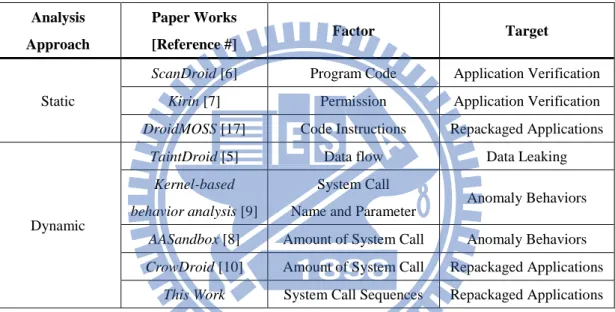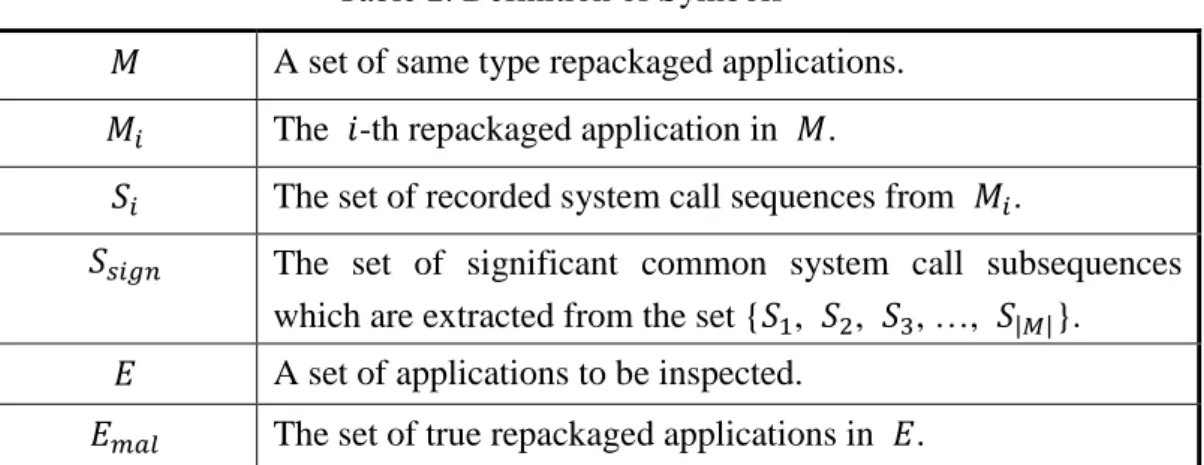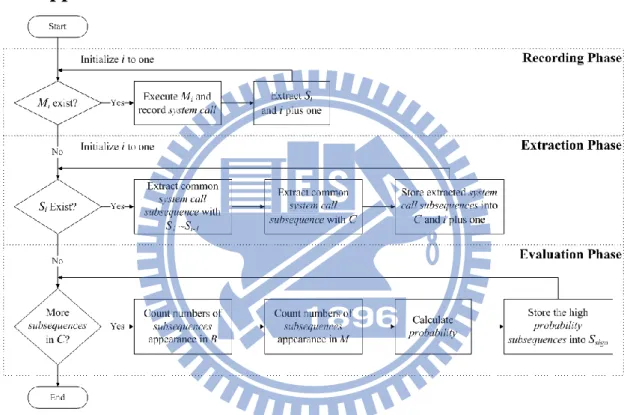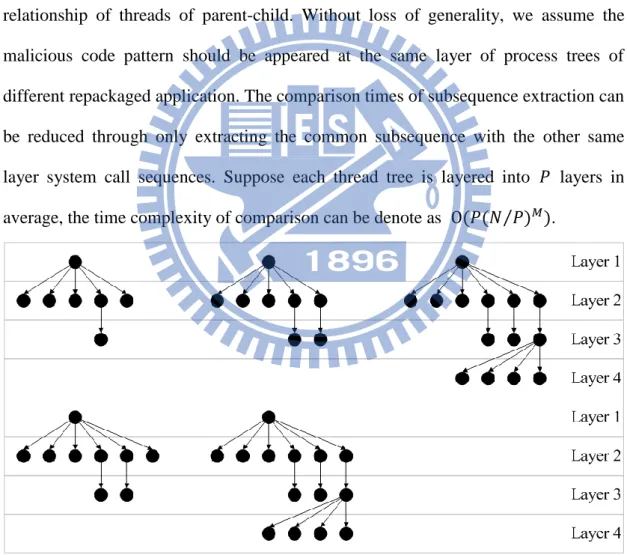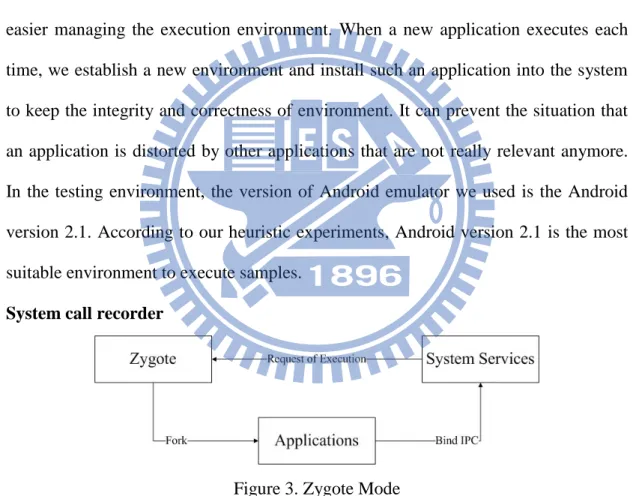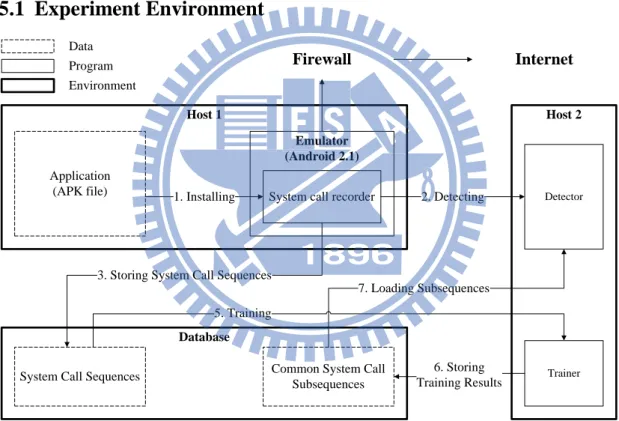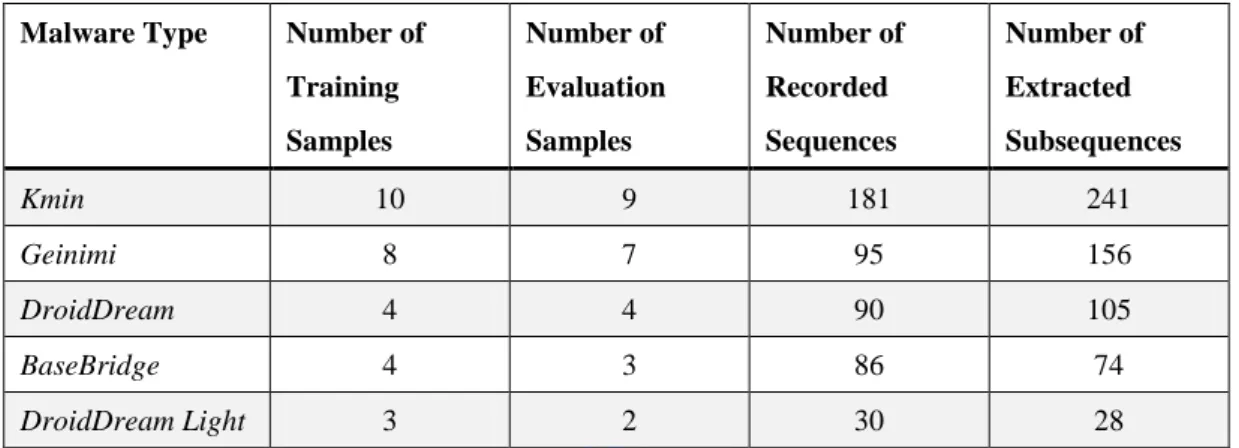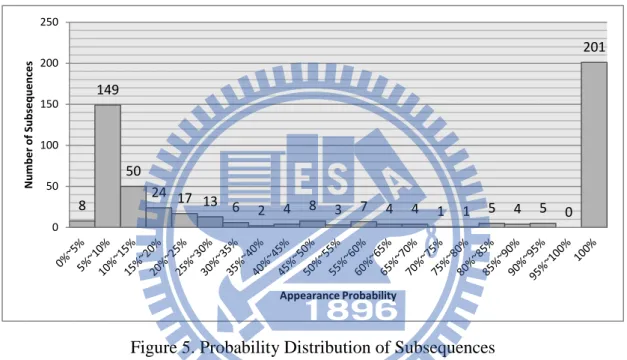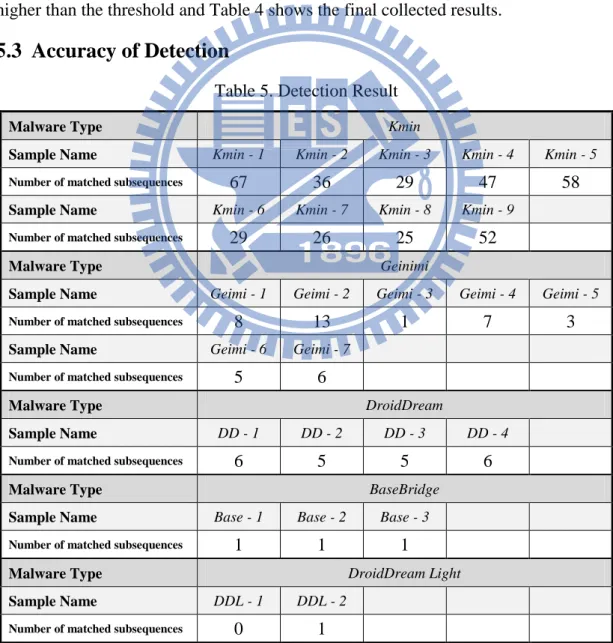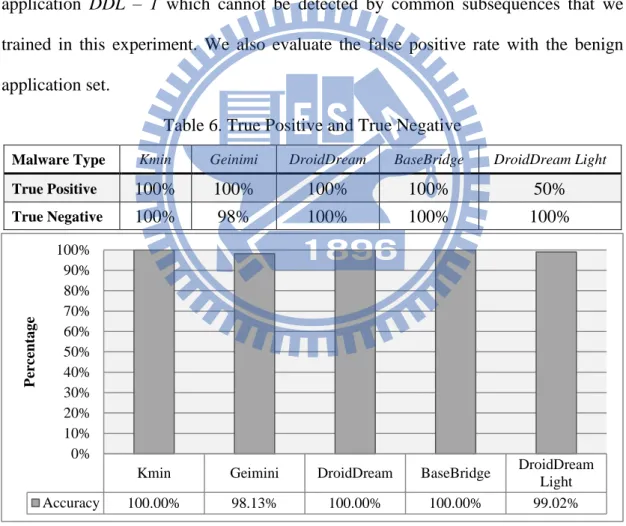國
立
交
通
大
學
網路工程研究所
碩
士
論
文
利用行為相似性偵測 Android 平台惡意應用程式
Identifying Malicious Applications by Behavioral Similarity on
Android Platforms
研 究 生:陳健宏
指導教授:林盈達 教授
II
利用行為相似性偵測 Android 平台惡意應用程式
Identifying Malicious Applications by Behavioral Similarity on Android
Platforms
研 究 生:陳健宏 Student:Chien-Hung Chen
指導教授:林盈達 Advisor:Dr. Ying-Dar Lin
國 立 交 通 大 學
網 路 工 程 研 究 所
碩 士 論 文
A Thesis
Submitted to Institute of Network Engineering
College of Computer Science
National Chiao Tung University
in partial Fulfillment of the Requirements
for the Degree of
Master in Computer Science June 2012 Hsinchu, Taiwan
中華民國一百零一年六月
III
利用行為相似性偵測 Android 平台惡意應用程式
學生: 陳健宏 指導教授: 林盈達
國立交通大學網路工程研究所
摘要
隨著行動裝置計算能力的提升與盛行,在手機上提供的應用程式越趨多樣化, 但卻同時成為了系統安全上新的攻擊目標。對於目前流行的 Android 系統平台, 攻擊者可以透過再包裝與混淆的技術,將惡意程式碼同時隱藏到多個看似一般的 應用程式來進行散佈,使得 Android 平台上的惡意程式偵測與分析工作更加的費 時和困難。然而,被打包惡意程式碼的應用程式即使有了不同的外表,但同樣的 惡意程式碼仍然會產生出同樣的行為,因此我們提出了一套利用系統呼叫序列來 進行應用程式的行為偵測方法,此方法能夠從多執行緒的惡意程式所產生的系統 呼叫序列中找出共同子序列,並且利用貝氏機率模型來過濾出有較高機率出現在 惡意應用程式,但較低機率在正常應用程式執行時出現的系統呼叫序列。最後我 們能夠利用這些抽取出來的系統呼叫序列,對待檢測的應用程式所執行的系統呼 叫序列中進行掃描。我們使用五個種類的被打包惡意程式碼的應用程式與一百正 常的應用程式來進行準確率的評估,在所有的種類裡面,我們的方法可以得到 97.6%的高準確率,在所有 25 個被檢測的惡意應用程式中,僅有一個沒有被辨識 出來。 關鍵字: 惡意應用程式,行為偵測,系統呼叫,AndroidIV
Identifying Malicious Applications by Behavioral Similarity on
Android Platforms
Student: Chien-Hung Chen Advisor: Dr. Ying-Dar Lin
Department of Computer and Information Science
National Chiao Tung University
Abstract
As mobile applications become popular, they become the new target of attackers.
For Android platforms, adversaries can easily repackage the malicious code into the
different benign applications for distribution. The work of detecting and analyzing the
malicious application becomes a challenge of Android. Though, the repackaged
applications have different outward appearances, the same malicious behaviors still
appear during runtime. Therefore, we propose a behavior-based detection mechanism
based on system call sequences. We extract the common system call subsequences of
malicious applications and purpose a comparison approach to deal with multiple
threads produced by the applications. We also utilize the Bayes probability model to
filter subsequences which have lower probability of appearance in the repackaged
applications. Finally, we can detect repackaged applications by those extracted
subsequences. In our experiment, we use five different types of repackaged
applications and 100 benign applications to evaluate the accuracy rate. The detection
result demonstrates that our approach has 97.6% high accuracy. We evaluate 25
repackaged applications and miss only one evaluated target.
V
Contents
List of Figures ... VI
List of Tables ... VII
Chapter 1. Introduction ... 1
Chapter 2. Background ... 4
2.1 Malware Differences between Desktops and Handhelds ... 4
2.2 Related Works on Desktop Environment ... 5
2.3 Related Works on Android Environment ... 6
Chapter 3. Problem Statement ... 9
3.1 System Call Sequence Detection ... 9
3.2 Problem Description ... 11
Chapter 4. Approach ... 12
4.1 Approach Overview ... 12
4.2 Extraction of System Call Subsequence ... 14
4.3 Sequence Evaluation with Probability of Appearing ... 16
4.4 Environment Implementation ... 17
Chapter 5. Evaluation... 19
5.1 Experiment Environment ... 19
5.2 System Call Sequences Distribution ... 20
5.3 Accuracy of Detection ... 22
5.4 Relationship of Training Samples and Sequences ... 24
5.5 Fixed-Length and Longest Common Subsequences ... 26
5.6 Case Study of Subsequences ... 28
Chapter 6. Conclusions and Future Works ... 31
VI
List of Figures
Figure 1. Flowchart of System Call Sequence Processing ... 12
Figure 2. Example of Thread Trees ... 15
Figure 3. Zygote Mode ... 17
Figure 4. Experiment Environment... 19
Figure 5. Probability Distribution of Subsequences ... 21
Figure 6. Accuracy of Detection ... 23
Figure 7. True Positive and True Negative of Different Training Sets ... 24
Figure 8. Sequences of Different Number of Repackaged Applications ... 25
Figure 9. Number of Subsequences of Different Approaches ... 27
Figure 10. Accuracy of Different Approaches ... 27
Figure 11. The Subsequence of Malicious Behavior ... 28
VII
List of Tables
Table 1. Related Works of Malicious Android Applications Detection ... 6
Table 2. Defincation of Symbols ... 10
Table 3. Number of Training Samples and Sequences ... 20
Table 4. The Number of Subsequences of 100% Probability ... 22
Table 5. Detection Result ... 22
Table 6. True Positive and True Negative ... 23
Table 7. Change of True Positive and True Negative ... 26
1
Chapter 1 Introduction
With the rapid increase of wireless mobile networks, the smart handheld have
become popular and bring us new applications and integration with existing online
services. Over the past decade, many operating systems have been developed to
provide a comprehensive infrastructure for these devices. Among them, the Android
platform, developed by Google, is one of the most popular mobile operating systems
because of its open source. A large community of developers has designed many new
applications for Android. Android provides an open environment called “Android Market” from which users can download applications. However, this scenario suffers from some weakness. An adversary can distribute their malicious applications that can
launch various security attacks including escalating privilege, monitoring users’
behaviors, and compromising the sensitive information at the end devices [1-3].
Especially, different from the traditional attacking mechanisms on the desktop, an
adversary can repackage the malware into the different benign applications to deceive
users installing the affected applications on mobile devices. Hence, detecting malware
from various applications becomes a challenge of Android [4].
Signature-Based Detection vs. Behavior-Based Detection
Typically, the malware detection mechanisms can be categorized into two types.
The first type is the signature-based detection mechanisms. We search the binary
image for the suspicious malicious patterns and then extract the unique signature for
each of them. Then we can identify malware by matching the binary image of these
applications with a database of signatures. Although signature-based detection
mechanisms are simple, efficient, and effective for the known existing malware, they
suffer from the drawback of not being able to detect the previously unknown malware.
2
therefore proposed. These mechanisms attempt to observe suspicious runtime
application behaviors. Independent of the binary image of malware, the
behavior-based mechanisms could significantly increase the detection rate for
unknown and obfuscated malware. Hence, the behavior-based mechanisms are more
suitable to detect the repackaged malicious applications.
To identify Android malicious applications, many detection mechanisms have
been proposed. For example, TaintDroid [5] tracks the information flow in the system
to identify the sensitive information leakage from applications, but it only detects the
malware that tries to obtain the sensitive data. In addition, ScanDroid [6] and Kirin [7]
attempt to verify the permission and the information flow in program codes before
users install applications. However, only codes with violated permissions in codes can
be identified as the malicious applications. Others detection mechanisms utilize the
kernel-based system calls to analyze the behaviors of malware. AAsandbox[8] counts
all system calls used in Android system to identify the anomaly. Isohara, et al. [9]
write a set of regular expression rules to matching in the repackaged applications.
CrowDroid [10] utilizes system calls to clustering benign and malicious applications.
But it suffers from a drawback of needing the original application to compare with the
repackaged one. According to our observation, none of them can be utilized to detect
all the repackaged applications efficiently.
To solve the problem of repackaged applications, we propose a novel
behavior-based detection version which relies on system call sequences. The key idea
is to observe the system call sequences that are trigger by applications, i.e., although a
malicious code can camouflage into a benign application, the malicious behavior still
appears in the system call sequences. Since the system call interface is embedded in
the kernel space at the low layer of Android architecture, processes are hard to hide
3
system call sequences in a set of same type but are repackaged malware by longest
common substring algorithm to find the longest sequence patterns. To filter out the
benign behaviors, we also employ the Bayes probabilistic model for evaluating the
appearance probability of extracted system call sequences to find the significant
malicious sequences. Through this approach, the repackaged malware can be detected
with high accuracy and the false positive rate can be reduced significantly.
The rest of this thesis is organized as follows. In Chapter 2, we give a brief
survey of related works which describes both desktop and Android environments. In
Chapter 3 and Chapter 4, we describe the details of the proposed mechanism on
processing system call sequences and its implementation, respectively. Some
experiment results and discussions are presented in Chapter 5. Finally, Chapter 6
4
Chapter 2 Background
In this chapter, we describe the issue on how to detect repackaged malicious
applications on the Android environment. Malware has been an issue on desktops
many years ago, and many works have been proposed to detect malware. In recent
years, malware has propagated to handhelds. Herein, we give a brief overview about
malware behavior differences between desktops and handhelds. Some related works,
such as malware detection by system calls on desktops and Android platforms, are
also discussed.
2.1 Malware Differences between Desktops and Handhelds
Compared with desktops, malware detection in handhelds suffers from some
limitations. Among them, one of the biggest problems is the power consumption.
Unlike powerful desktops, handhelds are only supported with finite energy from
batteries. This situation constrains us from exhausting the energy to detect malware.
The other problem is the limitation of the kernel of the operating system. For instance,
Android is built on the Linux kernel. Android applications are executed on the virtual
machine, Dalvik, which isolates applications by marking each application run as its
own user. Hence, it is hard to observe or to block the malicious application from our
programs without the root privilege. Due to these significant drawbacks, traditional
desktop based malware detection mechanisms cannot be performed on the Android
environment.
Many changes in malware’s purpose and behavior also lead us to improve
detection methods for the new circumstance. Basically, attack methods can be
categorized into two types: server-side attack and client-side attack. In a server-side
attack, attackers directly aim to the potential vulnerabilities in a server which exposes
5
utilizes this avenue for spreading. Fortunately, handhelds do not always access the
Internet services, a server-side attack cannot mount very well on handhelds. In
contrast, client-side attacks target vulnerabilities in client applications which interact
with the malicious server. Hence, attacker can construct a phishing site or embed the
malicious code into an ordinary server and infect applications of a client when a client
accesses the forgery information. For example, spyware and trojan horses are the two
typical instances to infect systems through this scenario. In addition, an attacker can
easily obtain the privacy information through the applications that have been infected
by spyware and trojan horses, i.e., the secret information can be obtained through the
SMS messages or phone calls. Compared with detecting worms and bots, it is a thorny
problem to detect spyware and trojan horses on handhelds.
2.2 Related Works on Desktop Environment
In the traditional desktop environment, signature-based detection is the most
popular technique used in anti-virus and intrusion detection systems. Unfortunately,
signature-based methods cannot detect the zero day malware. To overcome this
security flaw, many behavior-based methods were proposed. Among them, system
call is one of the popular techniques used to deeply monitor program behaviors.
Forrest, et al. [11] records the normal system call behaviors of a specific program into
a database. As the compromised program executing malicious code paths, the
anomalous system call sequence patterns are detected because the system call patterns
do not exist in the database. After that, many researches have extended the system call
approach and apply system call sequences into different models, such as hidden
Markov model [12], finite state automata [13], or Bayes model [14], to improve the
detection efficiency. Unfortunately, those proposed methods need to collect all the
behaviors in the specified programs. Collecting all behaviors in a large system, such
6
Christodorescu, et al. [15] apply malware behavior sequences into dependence
graphs and extract the subgraphs which do not appear in benign program for detecting
malware variants. Rozenberg, et al. [16] also collect fix length short system call
sequences from malware to detect unknown malware. In this work, we do the similar
but more force on multi threads processing and discover more precise system call
sequences to achieve the high accuracy for detecting repackaged applications.
2.3 Related Works on Android Environment
Table 1. Related Works of Malicious Android Applications Detection
Analysis Approach Paper Works [Reference #] Factor Target Static
ScanDroid [6] Program Code Application Verification
Kirin [7] Permission Application Verification
DroidMOSS [17] Code Instructions Repackaged Applications
Dynamic
TaintDroid [5] Data flow Data Leaking
Kernel-based behavior analysis [9]
System Call Name and Parameter
Anomaly Behaviors
AASandbox [8] Amount of System Call Anomaly Behaviors
CrowDroid [10] Amount of System Call Repackaged Applications
This Work System Call Sequences Repackaged Applications
Referring to Table 1, in the Android environment, many researchers focus on
how to verify Android applications. For instance, Enck, et al. [5] developed a novel
system called “TaintDroid”. The key idea is that they track the sensitive data by
labeling data in the memory and detecting the runtime privacy leaking behavior of
applications. Although TaintDroid system is simple and efficient, it only detects the
malware that attempts to obtain the sensitive data. For other types of repackaged
applications, TaintDroid cannot detect them well.
Kirin [6] utilizes a set of permission rules to block before installing applications
which require unsafe permission combination. ScanDroid [7] extracts security
7
code. They can identify malicious applications which violate permissions in codes.
AAsandbox [8] applies both static and dynamic approaches to analyze
applications. This means that it decompiles the installation file and then searches for
the suspicious patterns in the decompiled codes. During the application runtime,
AAsandbox counts all system calls used in Android system. However, AAsandbox
only sworks with specific malware, i.e., it cannot detect multiple types of malware.
This is because its dynamic approach only detects abnormal system call usage.
The method proposed by T. Isohara, et al. [9] collects the runtime information of
applications through system calls. They search some keywords in the names and
parameters of system calls to generate a set of regular expression rules. In addition,
they utilize the generated rules to search suspicious system calls and detect Android
malware. However, the malicious applications still have a chance to escape from
being detected by encapsulating or obfuscating the keyword in parameters.
CrowDroid [10] is another typical method to evaluate applications by using
system calls. After the system collects all the system calls used from a set of user
devices during the application runtime, it adopts K-means clustering algorithm to
classify the collected data into two groups, the benign group and the malicious group.
And the malicious group can be used to identify the specified user who is running the
repackaged application. CrowDroid needs a set of users to execute the same original
application or the repackaged application, nevertheless, find the original application
of all repackaged malicious applications is inefficient and impossible in Android
environment.
DroidMOSS [17] is a system which aims to discover repackaged applications in
the third-party marketplace. DroidMOSS calculates the similarity scores by
comparing the author information and code instruction hash between the original
8
finds the repackaged applications in the third-party marketplaces since the repackaged
application has a different appearance with the original application provided by the
official market. However, DroidMOSS has two weaknesses. Let us consider the
following scenario, i.e., once the malware is distributed both in the third-party
marketplace and in the official market, DroidMOSS cannot distinguish the malware
from the repackaged applications. The other is that not all of the original applications
can be obtained from the official market.
As a result of these incomplete methods, our proposed method aims to extract
longest system call sequences patterns from the same type of repackaged applications
and utilize the patterns to detect repackaged malware without the original applications.
Our contribution includes a new approach about extracting multi-thread common
system call sequences and applying the system call sequence to detect repackaged
9
Chapter 3 Problem Statement
To detect Android repackaged applications, we therefore proposed a
behavior-based detection mechanism. In the beginning of this chapter, we describe the
key idea that is adopted in the proposed mechanism. And then, we give the problem
statement in subsection 3.2.
3.1 System Call Sequence Detection
To disseminate malware to users, attackers usually embed their malicious codes
into the normal applications, and then publish these repackaged applications to the
official Android market or the third-party market. This dissemination path is simple,
efficient, and effective because the repackaged applications are like benign
applications to fool users into obtaining the secret information. In order to detect the
malicious repackaged applications, the proposed mechanism observers the behaviors
during the execution period of repackaged applications rather than the outward
appearance of repackaged applications. The key idea is that, even attackers can embed
the malicious codes into varies applications, the behaviors of executing applications
are consistent with the barely malicious code instructions. Hence, the proposed
mechanism observes the execution behaviors of application and then extracts the
common behavior patterns to distinguish malware.
For collecting application behaviors, we utilize the kernel-based system calls.
System calls provide interact between processes and the operating system kernel for
receiving service or resource requests. All service and resource requests can be
observed by monitoring the system call interface, and the sequential requests form up
a sequence of system calls. The observed system call sequence can be regarded as the
request behaviors during the application executing. There are other ways to collect
10
functionality to form up call sequences, but it would lead ambiguous because of its
multi-interfaces. Let us consider a scenario. For example, Android applications can
request a service of application framework through Android API or directly access the
libraries through Java Native Interface to achieve the same functionality. The
application can produce the same behavior but with different call interfaces, and the
call sequence will be more complicated if we need to integrate more than one
interfaces. It is also possible that the program gets the root permission and executes at
lower level than Android API and JNI. Hence, the proposed mechanism used system
calls not only simply indicate the running behavior of applications, but also record the
behavior of malicious codes completely than using high level function call.
Therefore, for detecting malicious repackaged applications, we initially collect a
set of same type repackaged applications . Let denotes the -th repackaged application in the set . Then, for each , we record the corresponding as a set of system call sequences. After that, we can extract the common system call
subsequences from the set { , , , …, | |} to derive the common
behavior patterns. Finally, for those undiscovered repackaged applications with
the same malicious codes, we can detect them from a set of applications to be
inspected by .
Table 2. Definition of Symbols
A set of same type repackaged applications. The -th repackaged application in .
The set of recorded system call sequences from .
The set of significant common system call subsequences
which are extracted from the set { , , , …, | |}. A set of applications to be inspected.
11
3.2 Problem Description
The detail problem description is given as follows. Given the Android platform,
a set of malicious repackaged applications, and a set of applications to be inspected,
design an approach to extract the behavior patterns of applications by system call
sequences, and aim to detect malicious repackaged applications with the same
malicious codes.
The problem could be defined as in the following:
Given
(1) the Android platform,
(2) a set of malicious applications , and (3) a set of applications to be inspected , suppose
(1) is the -th repackaged application in ,
(2) is the set of recorded system call sequences from ,
(3) is the set of significant common system call subsequences which are extracted from the set { , , , …, | |} and
(4) is the set of true repackaged applications in , the objectives are
(1) extract from and (2) identify from by .
12
Chapter 4 Approach
In this chapter, we detail the processing of our system call sequence detection
mechanism. In Section 4.1, we give an overview of system call sequence processing
which we present. The details of our approach are illustrated in Section 4.2 and
Section 4.3, respectively. Final, we describe the implementation issues in Section 4.4.
4.1 Approach Overview
Figure 1. Flowchart of System Call Sequence Processing
Figure 1 shows the overview of our approach. For extracting the common
behavior patterns, three phases, including recording phase, extraction phase, and
evaluation phase, are involved in the proposed approach. In the following, we first
describe these phases, respectively.
Recording Phase
In this phase, for all of applications in , we sequentially select an application from , and then execute the individually to record the system call requests during the Android system runtime. Next, we extract Si from all of system call data by
13
the process ID of and the corresponding child thread IDs. After all of
extracting, we can obtain in the recording phase. Extraction Phase
The extraction phase aims to extract a set of common system call subsequences
from all of . Since the same malicious code can trigger same system call sequences, we extract by Longest Common Substring (LCSs) algorithm for comparing system call sequences of different repackaged applications. In addition, to
improve the efficiency, we also present a mechanism for reducing the time cost of
extracting within multi-thread system call sequences. Finally, is obtained and each common system call subsequence in is denoted as , where is the index of subsequences in . It needs to address clearly that we extract substring in the system call sequences. The substring is a consecutive part of system call sequences, but we
still denote it as subsequences since a substring is always a subsequence and most
works use subsequences to call their system call combinations.
Evaluation Phase
However, it is impossible for all of the extracted subsequence to be used as the
detection patterns. This is because some system call subsequences not only appear in
repackaged applications, but also in benign applications. For example, some extracted
subsequences are too short to be a part of malicious code. So, in the evaluation phase,
we evaluate appearance probability of subsequences to filter out non-discriminating
subsequences. We leverage the Bayes probabilistic model to calculate the probability
of by counting the number of each subsequence appearance in a set of benign
applications and . After that, we can indicate those non-discriminating subsequences in and filter out them because they have the lower probability. After filtering, we can get , which has the higher probability, appearance in malware
14
this phase. If an application matches the same system call subsequence pattern of
in execution time, we can claim that the application is repackaged with the
same malicious code.
4.2 Extraction of System Call Subsequence
Since the common malicious behavior is the most resemble part of repackaged
applications, the system call sequences which are collected from repackaged
applications should also contain the common subsequences. It is our hope to extract
the common subsequence of system call sequences to indicate the malicious behavior.
In the extraction phase, suppose that each system call names as an element, the LCSs
algorithm can find the longest common consecutive system call combination with two
different system call sequences. Figure 2 illustrated how to extract subsequence from
multiple applications in the extraction phase which contains two parts of procedure.
When a new is added to the procedure, the first part extracts subsequences
between and all of the processed sequence sets { , , , …, } in the queue. The second part extracts subsequences between and all of the extracted
subsequences in the storage. The second part can extract the common subsequences
more precious. After extracting the common subsequences, this procedure adds this
application into the queue, saves all of the extracted subsequences into the storage,
and processes for the next target.
Layering Multi-Thread Comparison
Android applications usually have multiple threads. Under this situation, we can
get several system call sequences from different threads of an application. To extract
system call subsequences by LCSs algorithm, the simpler way of processing multiple
sequences is to exhaust all combinations of two sequences. However, it leads the
heavy overhead if an application has many child threads. Suppose we have applications and each application has threads. The time complexity can be denote
15
as . To overcome this drawback, we present a Layering Multi-Thread
Comparison (LMTC) mechanism to reduce the processing overhead on multi-thread
system call sequences in the extraction phase. Since child threads have their parents,
we can establish the thread tree for each that depends on the relationship of
threads of parent-child. All of the threads are separated into several layers in the
thread tree. It is our observation, that same behaviors are usually appeared at the same
layer. Even these behaviors are belonged to different applications. Since every
application has a regular order of work processes, the order is also appeared in the
relationship of threads of parent-child. Without loss of generality, we assume the
malicious code pattern should be appeared at the same layer of process trees of
different repackaged application. The comparison times of subsequence extraction can
be reduced through only extracting the common subsequence with the other same
layer system call sequences. Suppose each thread tree is layered into layers in average, the time complexity of comparison can be denote as ⁄ .
Figure 2. Example of Thread Trees
Figure 2 shows a clearer example of the process trees of malware “DroidDream
Light”. The five thread trees are extracted from five different applications which are
16
and the different number of child threads. Each node denotes an individual thread, and
the arrows indicate the relationship of parent-child between two threads. If we need to
extract common system call subsequences from these five process trees, for each
sequence extraction, each thread tree needs to compare the chosen thread with the
other four threads. The total number of extract combinations is 98784 ( ). However, only 5437 extract combinations are available by applying LMTC in this example. ( 1 ( ) combination in the first layer, 5400 ( ) combinations in the second layer, and 36 ( ) combinations in the third layer, respectively. It is worth noting that the fourth layer
has no combinations since some process trees do not have threads in the fourth layer.)
4.3 Sequence Evaluation with Probability of Appearing
We get a set of system call subsequences after the extraction phase, but not all of
the extracted subsequences can be guaranteed as the truly malicious applications that
do not appear in the benign applications. Therefore, we have to evaluate the extracted
subsequences in terms of the probability of appearance under the Bayes probability
model. The probability formula is calculated as
) 1 ( , ) ( ) | ( ) ( ) | ( ) ( ) | ( ) | ( B P B C P M P M C P M P M C P C M P j j j j
where the is the system call subsequence that is used to evaluate. denotes the probability that the given applications are benign applications. denotes the probability that the given applications is a repackaged application. ( | ) denotes the probability that the subsequences appear in benign applications, and ( | ) denotes the probability that the subsequences appear in repackaged applications.
Finally, we can get the probability ( | ) that an application is a repackaged application, detected by the specific system call subsequence. In the first step of
17
applications and malicious applications. Then, in the second step, we can calculate the
probability ( | ) by the formula (1). After the processing of probability calculation, we obtain the subsequences that appeared in the malicious application has
the higher probability than that of benign applications. And this information helps us
to find which achieves the higher accuracy for detecting repackaged
applications.
4.4 Environment Implementation
To execute a large amount of applications, we deploy the Android emulator for
easier managing the execution environment. When a new application executes each
time, we establish a new environment and install such an application into the system
to keep the integrity and correctness of environment. It can prevent the situation that
an application is distorted by other applications that are not really relevant anymore.
In the testing environment, the version of Android emulator we used is the Android
version 2.1. According to our heuristic experiments, Android version 2.1 is the most
suitable environment to execute samples.
System call recorder
Figure 3. Zygote Mode
For recording the system calls during the period of system runtime, we use the
tool “strace” [18] to trace system calls and signals in Linux kernel. We change the
boot configuration of Android emulator to make strace attach on Zygote. As
illustrating in Figure 3, Zygote is a monitor process of an Android system. It usually
18
new applications will be forked from Zygote and executed. This procedure is called
Zygote Mode. Since all of the Android applications are forked from Zygote, strace can
monitor all of the executed Android applications by tracing the child processes of
Zygote. strace individually records system calls of different threads into separated
files, and each thread produces system call sequences. After the time quantum is large
enough to record system calls, we can extract the system call sequence of the
application that we want to monitor by its process ID. Moreover, the child sequences
can be traced by checking whether the thread had forked any child threads. The
behavior of producing a child thread can be found by clone and fork system calls in
the system call sequence. The system call sequences of child threads are also
19
Chapter 5 Evaluation
We use five types of repackaged applications to evaluate the effectiveness of our
approach. Initially, we describe the experiment environment and the used application
samples in Section 5.1. In Section 5.2, we present the utility of system call sequences
extraction and evaluation of our approach. Finally, the accuracy of malware detection,
including false positive and false negative, are discussed in Section 5.3 and Section
5.4.
5.1 Experiment Environment
Host 1 Emulator (Android 2.1) Application(APK file) 1. Installing System call recorder
Host 2
Detector
2. Detecting
Database
System Call Sequences Common System Call
Subsequences 3. Storing System Call Sequences
Trainer 6. Storing Training Results Internet 5. Training 7. Loading Subsequences Data Program Environment Firewall
Figure 4. Experiment Environment
Figure 4 illustrates the experiment environment which includes three programs:
system call recorder, trainer, and detector. The system call recorder is implemented in
the emulator. The emulator is continuously connected to Internet for grabbing more
behaviors of applications due to the reason that, some application behaviors need to
interact with the Internet. The trainer program is responsible for the system call
20
applications resorting by matching with common system call subsequences that are
trained by the trainer program before.
Table 3. Number of Training Samples and Sequences
Malware Type Number of
Training Samples Number of Evaluation Samples Number of Recorded Sequences Number of Extracted Subsequences Kmin 10 9 181 241 Geinimi 8 7 95 156 DroidDream 4 4 90 105 BaseBridge 4 3 86 74 DroidDream Light 3 2 30 28
For evaluating our approach, we prepare five different repackaged application
types: Kmin [19], Geinimi [20], DroidDream [21], BaseBridge [22] and DroidDream
Light [23]. Each repackaged application type has a number of applications, and we
divide those repackaged applications into two parts as Table 2 listed. The first part is
used to extract the common system call subsequences, and the second part to evaluate
the false negative of detection rate of our approach. We also collect two sets of benign
applications. The first set is used to evaluate the appearance probability of common
system call subsequences for excluding useless subsequences, and the other set to
evaluate the false positive of detection rate of our approach. The benign applications
are collected from a third-party web site. For ensuring the benign property, we utilize
several anti-virus tools [24] to check whether those applications are virus-free. For
each of benign and repackaged application samples, we record the system call
sequences for 3 minutes. Since the efficiency of LCSs algorithm can be lower when
computing with long sequences, we only record the first 5000 system calls of each
thread. However, only few threads can generate more than 5000 system calls in
3minutes.
21
Initially, we record the system call sequences of repackaged applications. The
number of total recorded sequences of each type is showed in Table 3. After the
system call sequences are recorded, by our extraction algorithm, we get another set of
sequences that are the common system call subsequences. For each extracted common
subsequence, we also apply a SHA1 digest algorithm for it to prevent the duplicate
subsequences. We extract the subsequences of each type individually. Table 2 shows
the result about the number of extracted sequences.
Figure 5. Probability Distribution of Subsequences
After the extraction, we count the number of subsequences appearance in the
benign application set and the repackaged application set from which the
subsequences are extracted for the training of Bayes probability. At first, we prepare
300 benign applications as the benign application set. The repackaged application set
is also prepared as listed in Table 3. After the calculation by Bayes probability model,
Figure 5 shows the probability distribution of subsequences. We calculate the
probability in five different types of repackaged applications, and the number of
subsequences is the sum of five results. Most of subsequences are distributed at the
interval 10%~15% and 100%. The higher probability of subsequences means if the
subsequences are discovered in an application, it has higher probability that the
8 149 50 24 17 13 6 2 4 8 3 7 4 4 1 1 5 4 5 0 201 0 50 100 150 200 250 Num be r of Sub se que nce s Appearance Probability
22
application is repackaged. We select higher probability subsequences as the
significant common system call subsequences.
Table 4. The Number of Subsequences of 100% Probability
Malware Type Kmin Geinimi DroidDream BaseBridge DroidDream Light
Number of
Subsequences 158 28 9 3 3
We exclude the subsequences with lower probability than threshold, and we set
the threshold as 100% initially. After excluding these subsequences, we can collect
the significant common system call subsequences which have a probability that is
higher than the threshold and Table 4 shows the final collected results.
5.3 Accuracy of Detection
Table 5. Detection Result
Malware Type Kmin
Sample Name Kmin - 1 Kmin - 2 Kmin - 3 Kmin - 4 Kmin - 5
Number of matched subsequences 67 36 29 47 58
Sample Name Kmin - 6 Kmin - 7 Kmin - 8 Kmin - 9
Number of matched subsequences 29 26 25 52
Malware Type Geinimi
Sample Name Geimi - 1 Geimi - 2 Geimi - 3 Geimi - 4 Geimi - 5
Number of matched subsequences 8 13 1 7 3
Sample Name Geimi - 6 Geimi - 7
Number of matched subsequences 5 6
Malware Type DroidDream
Sample Name DD - 1 DD - 2 DD - 3 DD - 4
Number of matched subsequences 6 5 5 6
Malware Type BaseBridge
Sample Name Base - 1 Base - 2 Base - 3
Number of matched subsequences 1 1 1
Malware Type DroidDream Light
Sample Name DDL - 1 DDL - 2
Number of matched subsequences 0 1
23
applications listed in Table 3 to evaluate the false negative of detection rate. In
addition, we also prepare 100 benign applications to evaluate the false positive of
detection rate. We put the significant common system call subsequences which are
extracted from different types independently of the five type sets. Then, we take those
subsequences as the pattern to match in the system call sequences of the same type of
repackaged applications. An application is detected as a repackaged application if it
has the same subsequence in its system call sequences. Table 5 shows the detected
result. Most of repackaged applications can be detected by our approach, except the
application DDL – 1 which cannot be detected by common subsequences that we
trained in this experiment. We also evaluate the false positive rate with the benign
application set.
Table 6. True Positive and True Negative
Malware Type Kmin Geinimi DroidDream BaseBridge DroidDream Light
True Positive 100% 100% 100% 100% 50%
True Negative 100% 98% 100% 100% 100%
Figure 6. Accuracy of Detection
Suppose that true positive ( TP ) denotes the percentage of repackaged
applications detected correctly, and false negative ( FN ) denotes the percentage of
repackaged applications detected incorrectly; on the contrary true negative ( TN )
Kmin Geimini DroidDream BaseBridge DroidDream
Light Accuracy 100.00% 98.13% 100.00% 100.00% 99.02% 0% 10% 20% 30% 40% 50% 60% 70% 80% 90% 100% P er ce nta g e
24
denotes the percentage of benign applications which are not detected by any excluded
subsequences, and false positive (FP) be the percentage of benign applications which
are incorrectly detected as repackaged applications. denotes the number of benign applications. denotes the number of repackaged applications. Table 6 demonstrates the true positive and true negative of detection rate that we evaluated
with prepared samples. And the Accuracy can be calculated as
) 2 ( %. 100 ) ( ) ( B FP TN M FN TP B TN M TP Accuracy
Our approach has a good accuracy rate to detect repackaged applications. It is
worth noting that, our approach has a very low false positive rate and a false negative
rate. For all of five type samples, we only miss one evaluated target in 25 repackaged
applications. For the 100 benign evaluation samples, our approach only has 2 false
positive of benign samples. The accuracy is 97%. Referring to Figure 6, compared
with other experimental results, only the true positive rate of DroidDream Light is
significantly lower than that of our results, but we only miss one target. And this
could be explained by an insufficient training and evaluation samples of DroidDream
Light.
5.4 Relationship of Training Samples and Sequences
Figure 7. True Positive and True Negative of Different Training Sets
For more detail study about the accuracy, we put all of the system call
100 96 96 64 89 98 0 20 40 60 80 100
29 Benign Samples 150 Benign Samples 300 Benign Samples
Per ce n tage (% )
25
subsequences which are extracted from different types together. First, we change the
number of benign training samples which are used to training the Bayes probability.
The first set is the 300 benign samples that we initially used. The second set is the half
of the first set. And the number of samples of third set is same as the total number of
malicious training samples showed in Table 2.
All of three sets are trained with the same 29 malicious samples. We take these
three sets to evaluate true positive and true negative in the same benign and malicious
evaluation samples of Chapter 5.3. Figure 7 shows the result. If we add more benign
samples to training, we can get a higher true negative rate. However, it is possible to
get a lower true positive rate, since the more benign training samples we used will
cause more subsequences are filtered. And the malware detection ability is also
reduced because we get less subsequence.
Figure 8. Sequences of Different Number of Repackaged Applications
The second part we evaluate is to reduce the number of malicious training
samples. We select Kmin and Geinimi as two independent samples sets. For each of
the malicious training samples set, we divide in half to get another two sets for
observing the changes. All the four sets are trained with the same 300 benign samples.
Figure 8 show that when we used less malicious samples to extract common
subsequences, we got fewer subsequences. And the number of sequences of 100%
241 112 156 65 158 65 28 7 0 50 100 150 200 250 300
Kmin (10 training samples) Kmin (5 training samples) Geinimi (8 training
samples) Geinimi (4 training samples) Num be r of Se que nce s Number of Extracted Sequences Number of Sequences of 100% Probability
26
probability is also reduced in the similar proportion.
Table 7. Change of True Positive and True Negative
Malware Type Kmin
(10 samples) Kmin (5 samples) Geinimi (8 samples) Geinimi (4 samples) True Positive 100% 100% 100% 100% True Negative 100% 100% 98% 100% Accuracy 100% 100% 98.13% 100%
We also evaluate the detection accuracy of these four sets. As Table 7 showed, if
we use less malicious training samples, the true negative rate is increased. But it is
possible to get a poor true positive rate if we reduce more malicious training samples.
Since the less malicious training samples we used, the less subsequence can be
extracted. Both of the miss match of benign samples and the detection ability of
malicious samples are reduced.
Table 8. The Relationship of Number of Samples and Sequences (Kmin)
Number of Malicious Training Samples Number of Extracted Sequences Number of Benign Training Samples Number of Sequences of 100% Probability 10 241 300 158 10 241 150 161 5 112 300 65 5 112 150 67
Finally, we use Kmin as the example to show the relationship between the
number of samples and the number of sequences in Table 8. It can be observed more
malicious training samples result in more extracted sequences. However, there are
less sequences can be obtained when more benign training samples are used for
training. So, if we take more malicious samples to train for increasing the true positive
rate, the benign training samples should also be increased to keep the high true
negative rate.
5.5 Fixed-Length and Longest Common Subsequences
27
our approach with other works which use the fixed-length common subsequences. For
example, Rozenberg, et al. [16] using 15 system calls as the length of subsequences.
So we compare the accuracy of detection between using the longest common
subsequences and the fixed-length common subsequences of length 15.
Figure 9. Number of Subsequences of Different Approaches
Figure 9 shows the number of extracted subsequences and the number of
subsequences which doesn’t appear in our benign training samples by using different
approaches. For using the fixed-length common subsequences of length 15, the
number of extracted subsequences is dramatically higher than using the longest
common subsequences. After filtering by our training, the numbers of common
subsequences of length 15 are still very high.
Figure 10. Accuracy of Different Approaches
After the filtering, we use these two sets of common subsequences to evaluate
516 201 6206 2956 0 1000 2000 3000 4000 5000 6000 7000
Number of Extracted Subsequences Number of Subsequences of 100%
Probability
Longest Common Subsequences Fixed-Length Common Subsequences(Length 15)
98% 96% 97.60% 88% 100% 90.40% 0% 20% 40% 60% 80% 100%
True Negative True Positive Accuracy
28
the accuracy with the same groups of repackaged applications and benign applications.
As the Figure 10 indicates, using the longest common subsequences has higher true
negative than using the fixed-length. In the 100 benign applications, fixed-length
common subsequences have 12 false positives. But longest common subsequences
only have 2. However, longest common subsequences has lower true positive rate
since we have one false negative. Applying to the formula (2), the result shows that
using the longest common subsequences has a higher accuracy than using
fixed-length. The longest common subsequences reduce both the false positive rate
and the number of subsequences which we use for detecting.
5.6 Case Study of Subsequences
Two case studies are prepared to clarify the content of subsequences we
extracted and the reason of false positive.
Malicious Behavior
1 stat64("/data/data/com.droiddream.lovePositions/shared_prefs/pref_config_setting.xml", 0xbea238c8) = -1 ENOENT
(No such file or directory)
2 ioctl(10, 0xc0186201, 0xbea237f8) = 0 3 ioctl(10, 0xc0186201, 0xbea237f8) = 0 4 ioctl(10, 0xc0186201, 0xbea237f8) = 0 5 ioctl(10, 0xc0186201, 0xbea237f8) = 0 6 ioctl(10, 0xc0186201, 0xbea237f8) = 0 7 ioctl(10, 0xc0186201, 0xbea237f8) = 0 8 ioctl(10, 0xc0186201, 0xbea237f8) = 0 9 ioctl(10, 0xc0186201, 0xbea237f8) = 0 10 ioctl(10, 0xc0186201, 0xbea237f8) = 0 11 ioctl(10, 0xc0186201, 0xbea237f8) = 0 12 ioctl(10, 0xc0186201, 0xbea237f8) = 0 13 ioctl(10, 0xc0186201, 0xbea237f8) = 0 14 ioctl(10, 0xc0186201, 0xbea237f8) = 0 15 ioctl(10, 0xc0186201, 0xbea237f8) = 0 16 ioctl(10, 0xc0186201, 0xbea237f8) = 0 17 ioctl(10, 0xc0186201, 0xbea237f8) = 0 18 ioctl(10, 0xc0186201, 0xbea237f8) = 0 19 ioctl(10, 0xc0186201, 0xbea237f8) = 0 20 mprotect(0x41adf000, 8192, PROT_READ|PROT_WRITE) = 0
21 socket(PF_INET6, SOCK_STREAM, IPPROTO_IP) = -1 EAFNOSUPPORT (Address family not supported by
protocol)
22 socket(PF_INET, SOCK_STREAM, IPPROTO_IP) = 26
23 getsockname(26, {sa_family=AF_INET, sin_port=htons(0), sin_addr=inet_addr("0.0.0.0")}, [16]) = 0
24 bind(26, {sa_family=AF_INET, sin_port=htons(0), sin_addr=inet_addr("0.0.0.0")}, 128) = 0
25 getsockname(26, {sa_family=AF_INET, sin_port=htons(60670), sin_addr=inet_addr("0.0.0.0")}, [16]) = 0
26 ioctl(26, FIONBIO, [1]) = 0
27 getsockname(26, {sa_family=AF_INET, sin_port=htons(60670), sin_addr=inet_addr("0.0.0.0")}, [16]) = 0
28 connect(26, {sa_family=AF_INET, sin_port=htons(8080), sin_addr=inet_addr("184.105.245.17")}, 128) = -1
EINPROGRESS (Operation now in progress)
Figure 11. The Subsequence of Malicious Behavior
We show a piece of subsequence which has malicious behaviors in Figure 9. It is
29
subsequence, the application checks whether the file “pref_config_setting.xml” has
existed at the first. If a device had been compromised by “DroidDream”, the file
“pref_config_setting.xml” should exist. This examination is implemented to avoid stealing information from the same devices again. Since our environment is clear, the
file “pref_config_setting.xml” should not exist in the file system. So, after the
examination, the application starts to ask the remote server (184.105.245.17) for
preparing to attack this device.
The Reason of False Positive
In our experiment of Chapter 5.3, our approach still has two false positives when
detecting a benign application as a malicious one. These two cases are caused by the
same subsequence which is extracted from malware “Geinimi”.
1 prctl(0x8, 0x1, 0, 0, 0) = 0 2 setgroups32(2, [3003, 1015]) = 0 3 setgid32(10028) = 0 4 setuid32(10028) = 0 5 gettid() = 251 …… 95 open("/data/app/com.moonbeam.android.magicshop.apk", O_RDONLY|O_LARGEFILE) = 24 96 lseek(24, 0, SEEK_CUR) = 0 97 lseek(24, 0, SEEK_END) = 3493907 98 lseek(24, 0, SEEK_SET) = 0 99 lseek(24, 3493885, SEEK_SET) = 3493885 100 read(24, "P", 1) = 1 101 read(24, "K", 1) = 1 102 read(24, "\5", 1) = 1 103 read(24, "\6", 1) = 1 104 lseek(24, 0, SEEK_CUR) = 3493889 105 lseek(24, 0, SEEK_CUR) = 3493889 106 lseek(24, 0, SEEK_END) = 3493907 107 lseek(24, 3493889, SEEK_SET) = 3493889 108 lseek(24, 3493889, SEEK_SET) = 3493889 109 read(24, "\0\0\0\0\30\1\30\1\2H\0\0\373\0075\0\0\0", 18) = 18 110 lseek(24, 0, SEEK_CUR) = 3493907 111 lseek(24, 0, SEEK_END) = 3493907 112 lseek(24, 3493907, SEEK_SET) = 3493907 113 lseek(24, 3475451, SEEK_SET) = 3475451 114 read(24, "PK\1\2\24\0\24\0\10\0\10\0\262\246T=j\260l\257\322\34\0"..., 4096) = 4096 115 lseek(24, 3479547, SEEK_SET) = 3479547 116 read(24, "\0\0\0\367\226i;H\360\30PH\266\0\0H\266\0\0\23\0\0\0\0"..., 4096) = 4096
Figure 12. The Case of False Positive
Referring to Figure 10, the subsequence is the case of false positive which is
executed when an application startup. This subsequence contents some of preparing
operations before the system reads the content of applications. So, it is possible to
appear both in repackaged applications and benign applications. However, the
30
subsequence contents 116 system calls which is too long. Therefore, it has small
probability to happen again in other applications although the subsequence only
31
Chapter 6 Conclusions and Future Works
Due to openness and accessibility of Android, adversaries can repackage
malicious code into the malicious applications as the benign applications. For users,
the outward appearance of repackaged applications is like a normal application, and
they are prone to distribute on marketplaces. Over the past few years, most of related
works detect repackaged applications by comparing them with the original benign
applications. However, it is computational infeasible to search all original applications
in the Internet. To overcome this drawback, we present an approach with the concept
on extracting the common behaviors of repackaged applications in system call
sequences. The detection only requires a few repackaged applications with the same
type to extract the common system call subsequences. In addition, our approach does
not need to collect and compare the original benign applications with the repackages
applications. We take those extracted common system call subsequences as the
behavior patterns to detect repackaged applications.
In our experiment, we use five different types of repackaged applications to
evaluate the accuracy rate. Our approach extracts 238 common system call
subsequences from training samples, and the detection result demonstrates that our
approach has higher true positive rate in detecting most repackaged applications. We
evaluate 25 repackaged applications and only miss one evaluated target. Our approach
also has higher true negative rate in verifying benign applications. The accuracy of
detection rate is 97.6% in all of evaluation applications.
However, the evasion is still possible in the system call sequences detection. For
example, the attacker can insert some system calls which are no effect to its behavior
but can change the combination of system call sequences. To prevent this situation,
32
repackaged applications can produce the same thread into different layers to escape
from our sequences extraction since our approach only compare between the
sequences of same layers. But we still can compare between all of the sequences
rather than only the same layers to prevent this scenario.
In the future, we hope to study application behaviors analysis. We only can
record the behaviors which are automatically generated from applications. However,
applications have more behaviors when users perform the related operations.
Therefore, we need to design a tool to grab the complete behaviors in the applications
when they are triggered. Moreover, we also hope to develop an on-device detector of
system call sequences detection which can work like the anti-virus software that
33
Reference
[1] W. Enck, M. Ongtang, and P. McDaniel, “Understanding Android security,”
IEEE Security & Privacy Magazine, vol. 7, no. 1, pp. 10–17, 2009.
[2] T. Vidas, D. Votipka, and N. Christin, “All your droid are belong to us: A survey of current android attacks,” Proceedings of the 5th USENIX conference on
Offensive technologies, San Francisco, CA, USA, August 2011.
[3] Y. Zhou, and X. Jiang, “Dissecting Android Malware: Characterization and Evolution,” Proceedings of the 33rd IEEE Symposium on Security and Privacy, San Francisco, CA, May 2012.
[4] M. Zheng, P. P.C. Lee, and J. C.S. Lui, "ADAM: An Automatic and Extensible Platform to Stress Test Android Anti-Virus Systems,“ Proceedings of the 9th
Conference on Detection of Intrusions and Malware & Vulnerability Assessment (DIMVA'12), Heraklion, Crete, Greece, July 2012
[5] W. Enck, P. Gilbert, B.-G. Chun, L. P. Cox, J. Jung, P. McDaniel, and A. N. Sheth, “TaintDroid: An information-flow tracking system for realtime privacy monitoring on smartphones,” Proceedings of the 9th USENIX conference on
Operating systems design and implementation, Vancouver, BC, Canada, pp.
393–407, October 2010.
[6] W. Enck, M. Ongtang, and P. McDaniel, “On lightweight mobile phone application certification,” Proceedings of the 16th ACM conference on Computer
and communications security, Chicago, IL, USA, pp. 235–245, November 2009.
[7] A. P. Fuchs, A. Chaudhuri, and J. S. Foster, “SCanDroid: Automated security certification of Android applications,” Technical report, University of Maryland, 2009.
[8] T. l sing, . atyuk, A.-D. Schmidt, S. A. Camtepe, and S. Albayrak, “An android application sandbox system for suspicious software detection,”
Proceedings of the 5th International Conference on Malicious and Unwanted Software (Malware 2010), Nancy, France, pp. 55–62, 2010.
[9] T. Isohara, K. Takemori, and A. Kubota, “Kernel-based behavior analysis for Android malware detection,” Proceedings of the 7th International Conference on
Computational Intelligence and Security, Sanya, Hainan, China, pp. 1011–1015,
December 2011.
[10] I. Burguera, U. Zurutuza, and N. T. Simin, “Crowdroid: ehavior-based malware detection system for Android,” Proceedings of the 1st ACM workshop on
Security and privacy in smartphones and mobile devices, Chicago, IL, USA, pp.
34
[11] S. Forrest, S. A. Hofmeyr, A. Somayaji, and T. A. Longstaff, “A sense of self for Unix process,” Proceedings of the 1996 IEEE Symposium on Security and
Privacy, Oakland, CA, USA, pp. 120–128, May 1996.
[12] C.Warrender, S. Forrest, and B. Pearlmutter, “Detecting intrusions using system calls: Alternative data models,” Proceedings of the 1999 IEEE Symposium on
Security and Privacy, Oakland, CA, USA, pp. 133–145,May 1999.
[13] K. Wee, and B. Moon, “Automatic generation of finite state automata for detecting intrusions using system call sequences,” Proceedings of International
Workshop on Mathematical Methods, Models, and Architectures for Computer Network Security, St. Petersburg, Russia, 2003.
[14] D. Mutz, F. Valeur, G. Vigna, and C. Kruegel, “Anomalous system call detection,” ACM Transactions on Information and System Security, vol. 9, no. 1, pp. 61–93, February 2006.
[15] M. Christodorescu, S. Jha, and C. Kruegel, “Mining specifications of malicious behavior,” Proceedings of the the 6th joint meeting of the European software
engineering conference and the ACM SIGSOFT symposium on The foundations of software engineering, Dubrovnik, Croatia, pp.5–14, September 2007.
[16] B. Rozenberg, E. Gudes, Y. Elovici, and Y. Fledel, “A Method for Detecting Unknown Malicious Executables,” Proceedings of the 2011 IEEE 10th International Conference on Trust, Security and Privacy in Computing and Communications, Changsha, China, pp. 190–196, November 2011.
[17] W. Zhou, Y. Zhou, X. Jiang, and P. Ning, “DroidMOSS: Detecting repackaged smartphone applications in third-party Android marketplaces,” Proceedings of
the 2nd ACM Conference on Data and Application Security and Privacy, San
Antonio, TX, USA, February 2012.
[18] “strace,” available at: http://sourceforge.net/projects/strace/ [19] “Encyclopedia entry: Trojan:AndroidOS/Kmin.A,” available at:
http://www.microsoft.com/security/portal/Threat/Encyclopedia/Entry.aspx?Nam e=Trojan%3AAndroidOS%2FKmin.A .
[20] T. Strazzere, and T. Wyatt, “Geinimi Trojan Technical Teardown,” Lookout
Mobile Security, 2011.
[21] “ ookout Mobile Security Technical Tear Down,” ookout Mobile Security.
[22] “Android.Basebridge,” available at:
http://www.symantec.com/security_response/writeup.jsp?docid=2011-060915-4 938-99 .
[23] “Security Alert: New DroidDream Light Variant Published to Android Market,”
available at:
http://blog.mylookout.com/blog/2011/07/08/security-alert-new-droiddream-light-35
variant-published-to-android-market/ .
[24] “VirusTotal - Free Online Virus, Malware and URL Scanner,” available at: https://www.virustotal.com/ .
